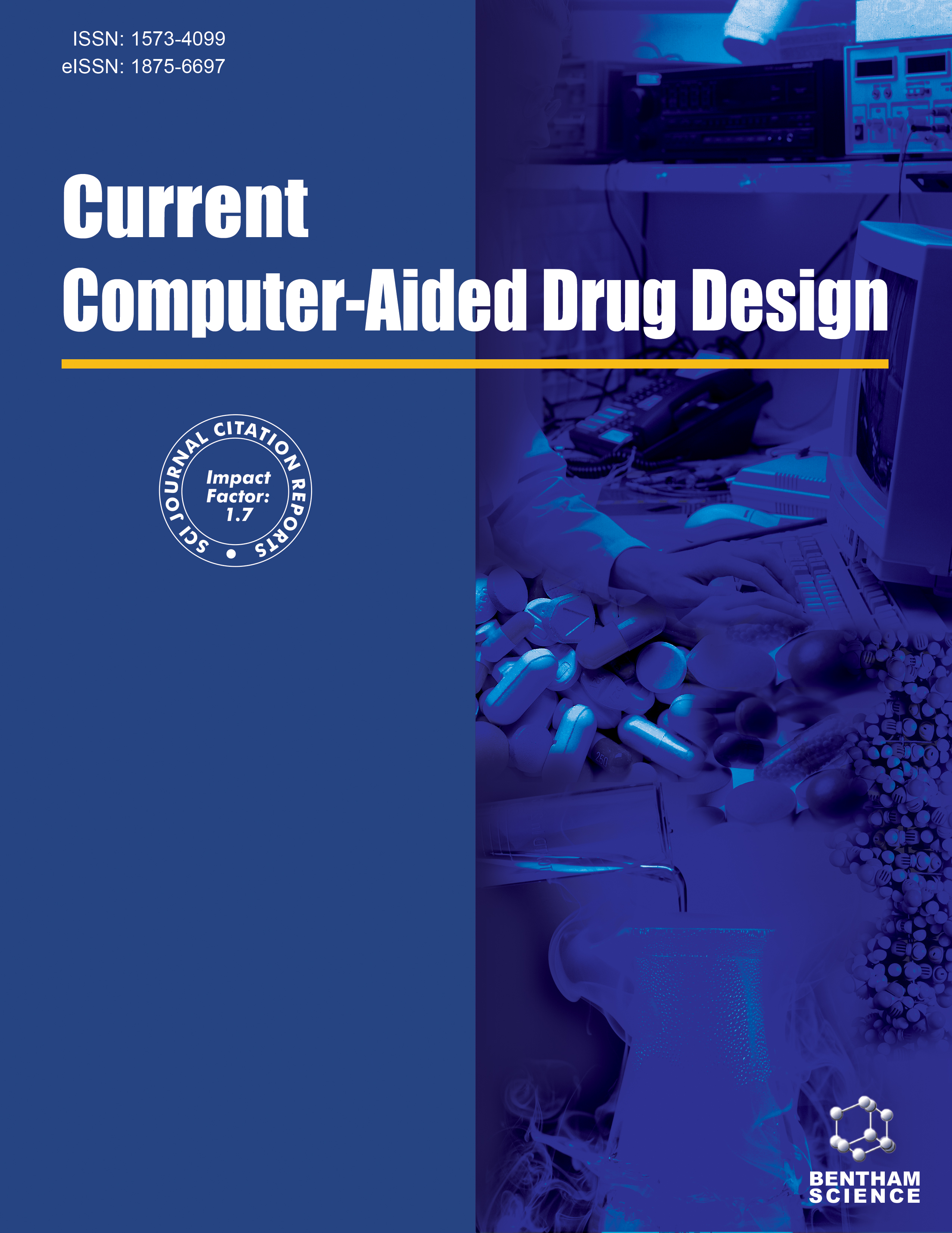- Home
- A-Z Publications
- Current Computer - Aided Drug Design
- Previous Issues
- Volume 16, Issue 2, 2020
Current Computer - Aided Drug Design - Volume 16, Issue 2, 2020
Volume 16, Issue 2, 2020
-
-
Evaluation of Chemotherapeutic Activity of the Selected Bases’ Analogues of Nucleic Acids Supported by ab initio Various Quantum Chemical Calculations
More LessAuthors: Piotr Kawczak, Leszek Bober and Tomasz BączekBackground: Pharmacological and physicochemical classification of bases’ selected analogues of nucleic acids is proposed in the study. Objective: Structural parameters received by the PCM (Polarizable Continuum Model) with several types of calculation methods for the structures in vacuo and in the aquatic environment together with the huge set of extra molecular descriptors obtained by the professional software and literatur Read More
-
-
-
In silico Analysis of Sulpiride, Synthesis, Characterization and In vitro Studies of its Nanoparticle for the Treatment of Schizophrenia
More LessBackground: Sulpiride, which has selective dopaminergic blocking activity, is a substituted benzamide antipsychotic drug playing a prominent role in the treatment of schizophrenia, which more selective and primarily blocks dopamine D2 and D3 receptor. Objective: This study has two main objectives, firstly; the molecular modeling studies (MD and Docking, ADME) were conducted to define the molecular profile of sulpiride a Read More
-
-
-
Molecular Docking Studies of Methamphetamine and Amphetamine-Related Derivatives as an Inhibitor against Dopamine Receptor
More LessAuthors: Kobra Foroughi, Mehdi Khaksari and Asghar ShayanniaBackground: The catecholamines such as dopamine, norepinephrine, and epinephrine are neurotransmitters that regulate different physiological functions of the central nervous system. Some evidence suggests that the degeneration of dopamine neurons in the substantia nigra contributes to Parkinson’s Disease (PD), which is a neurodegenerative disorder and it is responsible for the major symptoms of PD. It is suggested that Read More
-
-
-
De-Novo Ligand Design against Mutated Huntington Gene by Ligand-based Pharmacophore Modeling Approach
More LessAuthors: Anum Munir, Shaukat I. Malik and Khalid A. MalikBackground: Huntington's disease is characterized by three side effects, including motor disturbances, psychiatric elements, and intellectual weakness. The onset for HD has nonlinear converse associations with the number of repeat sequences of the polyglutamine mutations, so that younger patients have a tendency for longer repeats length. This HD variation is because of the development of a polyglutamine (CAG) r Read More
-
-
-
In silico Molecular Docking Study to Search New SGLT2 Inhibitor based on Dioxabicyclo[3.2.1] Octane Scaffold
More LessAuthors: Shubham Kumar, Gopal L. Khatik and Amit MittalBackground: Diabetes is a leading cause of high mortality rate in the world. Recently, SGLT2 inhibitors showed the promising result to treat diabetes and therefore several molecules are approved by the US FDA. Objective: SGLT2 inhibitors were designed based on dioxabicyclo[3.2.1] octane with the aim to search new lead molecule. Methods: The molecular structures were drawn in ChemBiodraw ultra and molecular docking stud Read More
-
-
-
Towards further Understanding the Structural Requirements of Combretastatin-like Chalcones as Inhibitors of Microtubule Polymerization
More LessAuthors: Naveen Dhingra, Anand Kar and Rajesh SharmaBackground: Microtubules are dynamic filamentous cytoskeletal structures which play several key roles in cell proliferation and trafficking. They are supposed to contribute in the development of important therapeutic targeting tumor cells. Chalcones are important group of natural compounds abundantly found in fruits & vegetables that are known to possess anticancer activity. We have used QSAR and docking studies to under Read More
-
-
-
Ligand-based Pharmacophore Model for Generation of Active Antidepressant-like Agents from Substituted 1,3,5 Triazine Class
More LessAuthors: Archana Gahtori and Abhishek SinghIntroduction: Although the transition of a lead candidate into a drug is currently structured by well-defined milestone, it is still most challenging and offers no guarantee in success to the end. In fact, ligand-based pharmacophore modeling has become a key motive force for retrieving potential leads across several therapeutic areas. Methods: An urgent need towards the development of novel antidepressant agents led us to gen Read More
-
-
-
Molecular Docking Based Analysis to Elucidate the DNA Topoisomerase IIβ as the Potential Target for the Ganoderic Acid; A Natural Therapeutic Agent in Cancer Therapy
More LessAuthors: Kaushal K. Sharma, Brijendra Singh, Somdutt Mujwar and Prakash S. BisenIntroduction: Intermediate covalent complex of DNA-Topoisomerase II enzyme is the most promising target of the anticancer drugs to induce apoptosis in cancer cells. Currently, anticancer drug and chemotherapy are facing major challenges i.e., drug resistance, chemical instability and, dose-limiting side effect. Therefore, in this study, natural therapeutic agents (series of Ganoderic acids) were used for the molecular doc Read More
-
-
-
Molecular Topological Properties of Alkylating Agents Based Anticancer Drug Candidates Via Some Ve-degree Topological Indices
More LessAuthors: Süleyman Ediz and Murat CancanBackground: Reckoning molecular topological indices of drug structures gives the data about the underlying topology of these drug structures. Novel anticancer drugs have been leading by researchers to produce ideal drugs. Materials and Methods: Pharmacological properties of these new drug agents explored by utilizing simulation strategies. Topological indices additionally have been utilized to research pharmacological pr Read More
-
Volumes & issues
-
Volume 21 (2025)
-
Volume 20 (2024)
-
Volume 19 (2023)
-
Volume 18 (2022)
-
Volume 17 (2021)
-
Volume 16 (2020)
-
Volume 15 (2019)
-
Volume 14 (2018)
-
Volume 13 (2017)
-
Volume 12 (2016)
-
Volume 11 (2015)
-
Volume 10 (2014)
-
Volume 9 (2013)
-
Volume 8 (2012)
-
Volume 7 (2011)
-
Volume 6 (2010)
-
Volume 5 (2009)
-
Volume 4 (2008)
-
Volume 3 (2007)
-
Volume 2 (2006)
-
Volume 1 (2005)
Most Read This Month
Article
content/journals/cad
Journal
10
5
false
en


